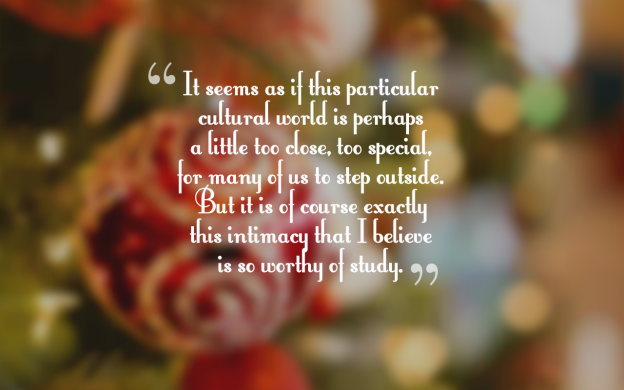By Lucinda Murphy, PhD researcher at Durham University
Well, here we find ourselves again in the depths of January; a new year well under way, and the realities of ‘the everyday’ forced back upon us. It feels somehow hard to imagine that, just a month ago, we were all immersed in an utterly different world. It is, as Shakespeare’s Caliban would have it, a world “full of noises, sounds and sweet airs”; a world in which realities are suspended, if not strangely magnified. It’s a world in which time stands still, dreams are indulged and escapist utopias entertained. It’s a world in which no expense is spared; a world of intensity in which expectations press, and emotions run high; a world in which everything seems to have that extra little bit of sparkle; a world which feels just a little bit ‘Christmassy’.
This annual shift into the world of ‘Christmas’ is of course second nature to most of us. Some dread it, some have fun laughing or even complaining about it, whilst others just seem to naively or feignedly ‘wish it could be Christmas every day’. Whichever angle of the spectrum you personally fit into; it seems clear that Christmas is a cultural event, and we might even say, phenomenon which can’t simply be ignored. Quite the contrary; the whole world seems to close down for it. In the UK, as in many other parts of the world during December, it’s pretty much inescapable. It is plastered across billboards, shop fronts and TV adverts; reinforced and cultivated by institutions of industry, public service and leisure; and physically adorned over and around both public and private spaces.
The very hint of even the word ‘Christmas’ conjures up a rich thought-world of symbol and meaning. Father Christmas; mince pies; snowy scenes; peace and goodwill; Christmas crackers; nativity plays; robins; carols; Quality Street; Christmas trees; candlelit churches. Quite clearly, the cultural symbolic resources for the weaving of such ‘webs of significance’ abound (Geertz, 1973). However, as Chris Deacy has recently shown in his 2016 book Christmas as Religion, these various weaves are neither distinctively personal or cultural, nor distinctively religious or secular. At Christmas, perhaps more than at any other time of year, many seem able, or at least willing, to balance multiple identity commitments, multiple emotions, and also multiple parts of their lives into one syncretic community spirited sparkly mixing bowl. And all the while, the perennial search for ‘the true meaning of Christmas’ hovers somewhere in the midst, casting hints of seeming authenticity into a festival which many fear often appears to be losing its ‘magic’ to empty commercialism and the outrageously ‘naff’.
What could be a more fertile window for the exploration of meaning making in Britain today; and more specifically into the complexities of ever-blurring religious and cultural identities? And yet, when I tell people I’m studying for a PhD on ‘Christmas’, I am met more often than not with astonished looks of incredulity. It’s often seen as too frivolous, too ‘fun’ to study (God help academia!). It seems as if this particular cultural world is perhaps a little too close, too special, for many of us to step outside. But it is of course exactly this intimacy that I believe is so worthy of study, and which I have been striving to capture in my ‘Christmassy’ fieldwork over the past few months. What is it exactly about this utopian dream-like world of stockings, magic dust, innocence, truth and fun that seems so personal; and perhaps more pertinently, how does it any of it relate to our ‘everyday’ January lives?
If you think you might be interested in pursuing some of these questions, do join my research assistant @MyElfGelf and I in our Christmassy musings by logging your own Christmas story as part of our online questionnaire, or by following our Festive Log Research adventures at lucindaslog.com or on Twitter or Facebook using #TheFestiveLog.

